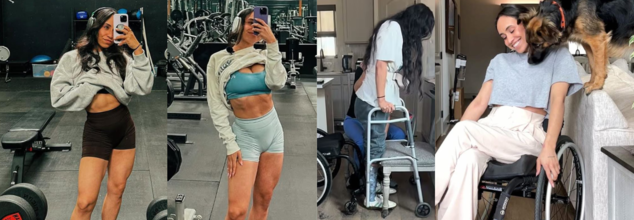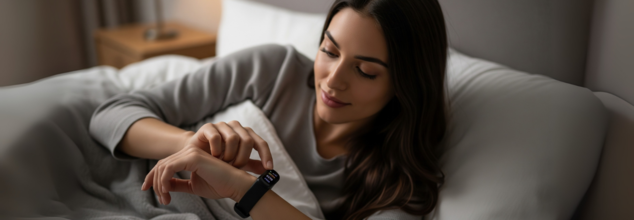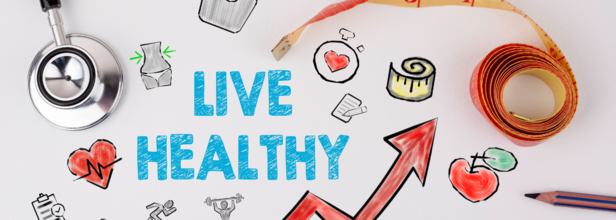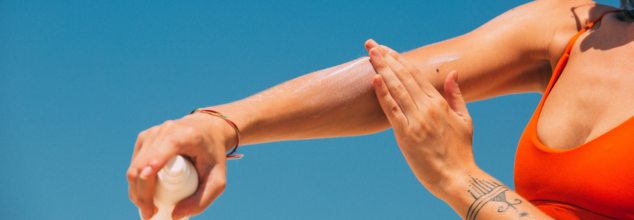- Health Conditions A-Z
- Health & Wellness
- Nutrition
- Fitness
- Health News
- Ayurveda
- Videos
- Medicine A-Z
- Parenting
- Web Stories
Fitness Influencer Left Paralyzed From Waist Down After Rare Tick Bite Infection Took Her Strength

Credits: Instagram(@planthlete_maria)/Kennedy News & Media
Fitness influencer Maria Palen, a chemical engineer known for her athletic lifestyle and 20,000-plus Instagram followers, is facing the unimaginable, regaining the ability to walk after being left partially paralyzed by a rare tick-borne illness. Punctuated by debilitating pain, medical uncertainty, and moments of hope, highlights how health can be derailed with the slightest ignorance or disease—even for those at peak fitness.
In early 2024, Palen start getting minor pains and aches—easily dismissed by most people. But by March, her world had turned around. Palen tells us that her "body completely gave up on me", leaving her on the cusp of immobility. Weighing 20 pounds lighter, in bed, unable to undertake even simple tasks such as locking her phone or opening a can of tuna, she confronted a harsh health deterioration unlike anything she'd ever seen.
A fitness expert who had built her life around health and outdoor activity, Palen struggled to reconcile her condition. “Why was my body failing me? I’ve always lived a healthy lifestyle,” she told her social media audience—only to learn that this was no ordinary illness.
After having been consulted by a number of experts, a diagnosis was made: babesiosis, a tick-borne parasitic infection caused by Borrelia microti. The parasite infects red blood cells, causing symptoms that vary from fever and chills to anemia and, in extreme instances, life-threatening complications.
Palen shared that she was bitten unaware while out hiking perhaps years before only to have the infection lie dormant until it broke out violently. In October, agonizing pain in the tailbone kept her from sitting. Numbness crept soon afterward from her legs up toward the belly button, and spinal fluid tests detected aberrant inflammation and high white blood cell levels. Physicians grappled with whether Lyme disease, babesiosis, or a neurotoxin was responsible.
In spite of aggressive antibiotic, antiparasitic, and pain control therapies, Palen's condition worsened neurologically. As pain medication was becoming effective, sensation waned. She explained how "my legs started going numb…until it crept all the way up to my belly button". The severity of her condition became apparent: something was interfering with her spinal cord function, although no cause was identified.
Physicians could merely provide cautious estimates: Palen had a 33% possibility of recovery, another 33% for partial recovery, the rest permanent paralysis. The intricated nature of her symptoms—spinal inflammation, destruction of red blood cells, and potential co-infection with Lyme disease—made it a daunting task to diagnose and treat her.
In spite of setbacks, December provided a glimmer of hope when Palen regained minimal movement in one leg. Through mid-2025, she is still reporting progress: strengthening stride, side steps under control, and small but significant gains in leg strength—albeit still lacking in quad muscle function and knee flexion.
Now living with family in Texas, Palen's rigorous rehabilitation involves eight hours a week of physical therapy, focusing on nerve growth, muscle building, and restoring mobility. She remains hopeful: "If not, I feel like mentally I would spiral," she said to PEOPLE, stressing that hope is crucial to her rehabilitation.
Palen's sickness didn't just derail her physical well-being but also her finances. She lost her job, apartment, and savings, prompting friends to set up a GoFundMe in January. The campaign has since raised over $12,000 to cover rising medical costs while she receives rehabilitation.
In spite of the uncertainty of diagnosis and rollercoaster of emotion, Palen persists. Her daily posts on social media highlight tiny triumphs—every restored step or feeling is cause for celebration as a symbol of resistance and strength.
Worse, co-infections are common: nearly 66% of Lyme disease patients also carry Babesia, making clinical presentations more difficult and diagnosis even later. In extreme cases—most notably among the elderly or immunosuppressed—the case-fatality rate can reach as high as 20%, raising a serious public health issue.
What is Babesiosis?
Babesiosis, which is caused by Babesia parasites, most often parades under the disguise of malaria in its initial stages, with fever, headaches, and muscle aches occurring one to six weeks following a tick bite. In extreme instances, it can cause organ failure, anemia, or hepatosplenomegaly. The Centers for Disease Control and Prevention (CDC) estimates mortality to be around 0.5% for babesiosis, but this is increased to 20% in the elderly or immunocompromised population. Palen's infection was especially severe, as it "completely shattered" her immune system, she said.
Ticks, tiny spider-like parasites measuring between 1mm and 1cm, are blood-feeders of mammals, including humans. In the United States, babesiosis is caused by two microbes: Babesia microti, which is transmitted by summer ticks, and B. duncani, which is spread by winter ticks during the fall and early winter. Although only around 2,500 cases are diagnosed each year, experts caution that others go undetected because of misdiagnosis or a lack of health provider awareness.
How Do You Keep Tick-Borne Illnesses from Happening?
Prevention is still the best method of avoiding severe tick-borne disease, say health authorities. The CDC and others advise:
- Wearing long sleeves, pants, and light-colored clothing when in tick-infested areas
- Using permethrin-treated clothing
- Conducting daily tick inspections—particularly after wilderness use
- Quick and careful removal of ticks with fine-point tweezers
Symptom monitoring—such as for unexplained fever, weakness, rash, or neurological findings—1–6 weeks after possible exposure. As Palen's experience illustrates, prompt detection can be life-changing, but also rare neurological complications, like spinal cord inflammation or paralysis, should be better known.
Although Palen has an indeterminate prognosis, her mind is still geared to the future. She continues to attend therapy, postures about her recovery, and stresses the need to stay mentally tough and surrounded by support groups. Daily function improves incrementally—a hopeful indication that nerve regeneration, even in the case of severe destruction, is possible.
Her case also highlights the necessity for immediate need for medical training, diagnostic equipment, and public education about tick-borne illnesses—including babesiosis—while rare, they can explode exponentially without early treatment. With climate change and habitat invasion fueling an explosion of tick populations, Palen's experience is an appeal to individuals to be cautious and to the medical community prioritize early detection and treatment.
Why Over-Tracking Your Health Could Be The New Cause Of Insomnia

Credits: Health and me
Every night, you check your sleep tracker hoping for that perfect score—only to wake up feeling more tired than rested. Sound familiar? In our quest to optimize everything—steps walked, calories burned, hours slept—we’ve turned health tracking into a full-time job. But while these devices promise better health, they may be quietly sabotaging our sleep. As it turns out, obsessing over numbers could be fueling a new form of insomnia—and your smart watch might be part of the problem.
In a culture obsessed with optimization, the wearables we once praised for boosting wellness may now be quietly sabotaging it. As health tracking becomes more pervasive and personal, an unexpected consequence is emerging: insomnia. Increasing evidence suggests that over-tracking our health—particularly sleep—is rewiring our brains to be more anxious, not more aligned.
While technology has allowed us to bridge gaps between medical monitoring and daily habits, it's also intensified our need for control, turning once-intuitive processes like sleeping into anxiety-laden performance metrics.
In just over a decade, wearable tech has gone from a niche fitness tool to a daily ritual. Smartwatches, fitness rings, calorie-tracking apps, heart rate monitors, and meditation platforms are now mainstream. For many, tracking steps, calories, and sleep cycles has become as routine as brushing teeth. According to a recent market report, over 400 million wearable devices were sold globally in 2024 alone.
The benefits are well-documented: a 2020 meta-analysis revealed fitness trackers increased daily activity by 1,800 steps on average. Continuous glucose monitors and ECG-enabled devices have empowered users to detect conditions early. But that same monitoring—when taken to the extreme—can flip into obsession.
Why is Over-Tracking a Problem?
Why do we track everything? For many, the drive comes from a desire for control in an uncertain world. When our health data is at our fingertips, it creates an illusion of mastery. But this constant self-surveillance can backfire.
Many of us mentally convert these tools from speedometers to judges, instead of neutral data, we start interpreting metrics as measures of our worth.
And herein lies the problem: tracking tools can trigger the brain’s threat-response system when we "fail" to meet goals. Not hitting your daily sleep score, breaking a meditation streak, or seeing a drop in heart rate variability can feel like failure. This stress can lead to hypervigilance, a known contributor to insomnia.
Why is Sleep The Most Tracked and Most Disturbed?
Of all tracked metrics, sleep is perhaps the most impacted. Ironically, those who obsessively monitor their sleep often report worse rest than those who don’t.
This condition even has a name: orthosomnia—a sleep disorder characterized by anxiety caused by trying too hard to sleep well, often triggered by the pursuit of perfect sleep data. When you’re constantly checking whether you slept well, you're already creating sleep anxiety. Sleep is meant to be automatic. Tracking turns it into a task.
Tracking health can lead to what psychologists call "displacement control"—where control is exerted in one measurable area (like steps or calories) to compensate for larger life uncertainties. For instance, someone feeling anxious about job instability may over-monitor their sleep and food intake, falsely believing that optimization here will lead to control elsewhere.
Moreover, wearables often misclassify sleep stages, leading to unnecessary worry. Many clients think they’re not getting deep sleep because their tracker said so, even if they feel rested.
When Tracking Becomes Harmful?
Not sure if you’ve crossed the line? Watch out for these signs:
- Feeling anxious when you forget your wearable or app
- Needing to validate a workout or meditation session with data
- Changing lifestyle choices solely to optimize metrics
- Worsening sleep or stress despite health-focused habits
- Experiencing guilt or shame when goals aren’t met
Healthy Habits to Avoid Over tracking Your Health
1. Take Intentional Tracking Breaks
Schedule device-free days. Go for a walk without counting steps. Eat without logging calories. Sleep without checking your "score." Reconnect with how your body feels rather than what data says.
2. Focus on Function, Not Perfection
Your sleep tracker should guide improvement, not demand perfection. Take metrics as suggestions, not mandates.
3. Learn About Sleep, Don’t Fear It
Understanding normal sleep patterns can prevent panic. For instance, 50% of sleep is light sleep—and that’s perfectly normal. It’s also healthy to take 20–30 minutes to fall asleep.
4. Ditch the Sleep Obsession
You don't need a device to sleep well. Maintain consistent sleep and wake times, limit screen exposure before bed, and avoid stimulants late in the day.
5. Redefine Success
Rather than focusing on streaks or scores, define success by how your habits impact your energy, mood, and life quality.
What About the Benefits of Tracking?
Wearable tech isn’t inherently harmful—it’s the way we use it that matters. When mindfully integrated, it offers helpful insights. Experts agree the best use of trackers is as feedback tools, not judgment tools.
Experts suggest using sleep data to see trends, not fixate on nightly stats. If a trend shows you sleep better on days you meditate or eat early, use that info to enhance—not control—your habits.
As AI continues to evolve, the next wave of health tech may shift toward emotional intelligence—offering mental wellness insights and personalized coaching rather than rigid metrics. Until then, the responsibility lies with us to set boundaries.
We’re still learning how to live in harmony with tech. It’s not about rejecting the tools but about reclaiming the authority they slowly chip away from us. You don’t need to monitor every heartbeat to live a healthy life. Sleep, eat, move, and breathe with balance. Trust that your body, not your data, knows what wellness feels like.
6 Ways To Lower Your Cholesterol Levels, Blood Pressure, And Dementia Risk In Just 20 Minutes

Credits: Canva
Supporting brain health isn’t just about preventing memory loss later in life—it's also about improving overall wellbeing, reducing the risk of stroke, and even managing cholesterol and blood pressure.
The good news is that there are simple, everyday actions that can strengthen the brain and help protect it from conditions like dementia. A professor of neurology at UCL and chief medical officer at Alzheimer's Research UK, as reported by SurreyLive, shares six effective ways to boost your brain this summer.
Keep Learning Something New
Challenging your brain with new skills helps strengthen neural connections and build what experts call "cognitive reserve." This means your brain becomes more resilient to the changes and damage that come with age. Whether it’s learning a language, picking up a musical instrument, or even trying a new hobby like painting or knitting, continuous learning keeps the brain flexible and adaptive.
The key is to choose something enjoyable. If it feels like a chore, you’re unlikely to stick with it. Sustained engagement in a skill encourages repeated use of specific brain areas, reinforcing those connections and helping your brain stay sharp over time.
Make Movement a Daily Habit
Exercise benefits both body and mind. It lowers risk factors like high blood pressure, high cholesterol, and obesity—all of which are linked to cognitive decline. Physical activity also improves mood, energy levels, and sleep quality, all of which contribute to better brain health.
Ideally, aim for some form of movement every day. This could include brisk walking, cycling, swimming, or even dancing. For maximum benefit, try to engage in more vigorous activity—something that raises your heart rate—for at least 20 minutes, three to four times a week.
Take Regular Walks
You don’t have to be a marathon runner to protect your brain. Even light-to-moderate physical activity like walking has significant long-term benefits. Walking regularly supports circulation, heart health, and brain function. It’s a low-impact, sustainable way to stay active, especially for those who are new to exercise or managing joint issues.
Walking outdoors also offers mood-boosting benefits, and doing it with a friend or in a group adds a valuable social dimension, which also helps protect cognitive health.
Stay Socially Connected
Maintaining strong social ties can be as important as diet and exercise when it comes to brain health. Social isolation has been linked to a higher risk of dementia and cognitive decline. Regular interaction with family, friends, or community groups helps keep the brain engaged and offers emotional support, feedback, and a way to gauge your mental sharpness.
Whether it’s meeting a friend for coffee, joining a club, or simply making a phone call, consistent connection with others plays a powerful role in keeping the mind active.
Monitor Your Blood Pressure
High blood pressure is a major contributor to vascular damage in the brain, which can lead to strokes, cognitive impairment, and forms of dementia. Managing blood pressure early—especially in your 30s and 40s—has a significant impact on brain health later in life.
Regular blood pressure checks, a heart-healthy diet, stress management, and exercise all contribute to keeping blood vessels strong and reducing the risk of long-term brain damage.
Use Brain Health Tools for Personal Insights
There are simple online tools available to help assess your brain health. These digital check-ins typically ask questions about lifestyle factors such as diet, physical activity, alcohol use, smoking, and sleep habits. Based on your responses, they offer personalized recommendations to improve your brain health over time.
Sunscreen Skin Care Against Skin Cancer - You Need A Lot More Than You Realize

(Credit-Canva)
How many times have you read the 'when' and ' how' to apply sunscreen the "correct" way because most people don't seem to use nearly enough. Experts have now shown exactly how much sunscreen you need to stay safe. This is crucial because sun exposure is the main cause of skin cancer worldwide. In the UK, melanoma skin cancer rates have jumped by almost a third in the last decade, making it the fifth most common cancer with about 18,000 diagnoses each year. A simple way to help prevent this disease is to always wear sunscreen when you're outdoors.
What is the "Seven Teaspoon" Rule Of Sunscreen?
It's likely you "need more than you think" when it comes to sunscreen. Which UK recently shared a video on Instagram, asking: "Are you putting on enough sun cream?" They highlighted some key points: you need seven teaspoons to safely cover your whole body. You should apply it 15 minutes before you go into the sun, and reapply every two hours (or more often if you're swimming or sweating a lot).- Breaking down those seven teaspoons:
- One teaspoon for your face and neck.
- Two teaspoons for your arms.
- Two teaspoons for your legs.
- One teaspoon for your stomach and chest.
- One teaspoon for your back.
The NHS supports this advice, warning that most people don't use enough sunscreen. They suggest aiming for six to eight teaspoons if you're covering your entire body. If you apply it too thinly, you won't get the protection it promises. If you expect to be in the sun long enough to risk burning, apply sunscreen twice: once 30 minutes before going out and again just before going out. Even if a product says "water resistant," you should reapply it after swimming or towel-drying, as the sun can dry it off your skin every two hours.
Who Needs Extra Sun Protection?
Some people need to be extra careful in the sun, particularly those with pale, white, or light brown skin, freckles, or red/fair hair, as they tend to burn easily instead of tanning. Individuals with many moles or skin problems due to medical conditions are also at higher risk. Those who are exposed to intense sunlight only occasionally such as during holidays or who travel to hot countries with strong sun exposure should take extra precautions. A family history of skin cancer further increases the need for vigilant sun protection.
Sunscreen products are rated with SPF (Sun Protection Factor) from 2 to 50+. A higher SPF number, like 50+, means stronger protection against harmful UVB rays.
How Can You Protect Your Skin Without Using Sunscreen?
While sunscreen is important, one must follow some other steps to ensure complete protection. Here are some tips you should remember according to American Academy of Dermatology Association.
Find Your Shade
The sun's rays are most powerful between 10 a.m. and 2 p.m. During these hours, it's best to seek shade. A good rule of thumb: if your shadow is shorter than you are, the sun is very strong, and you should definitely look for some cover.
Dress for Sun Protection
Whenever you can, wear sun-protective clothing. This means choosing things like a lightweight, long-sleeved shirt, long pants, a wide-brimmed hat, and sunglasses with UV protection. For even better defense, look for clothing labels that have an Ultraviolet Protection Factor (UPF) number, which tells you how much UV radiation the fabric blocks.
Say No to Tanning Beds
Both the sun and tanning beds give off harmful ultraviolet (UV) light, which can cause skin cancer and wrinkles. It's best to avoid tanning beds completely. If you want to have a tanned look, consider using a self-tanning product instead, but remember to still use sunscreen along with it for actual sun protection.
Be Extra Careful Near Reflective Surfaces
You need to be especially cautious when you're near water, snow, or sand. These surfaces are highly reflective, meaning they bounce back the sun's damaging rays, which can significantly increase your chance of getting a sunburn.
© 2024 Bennett, Coleman & Company Limited

